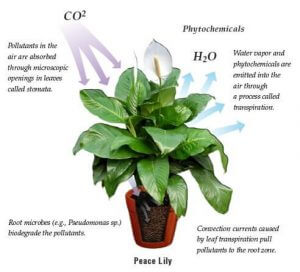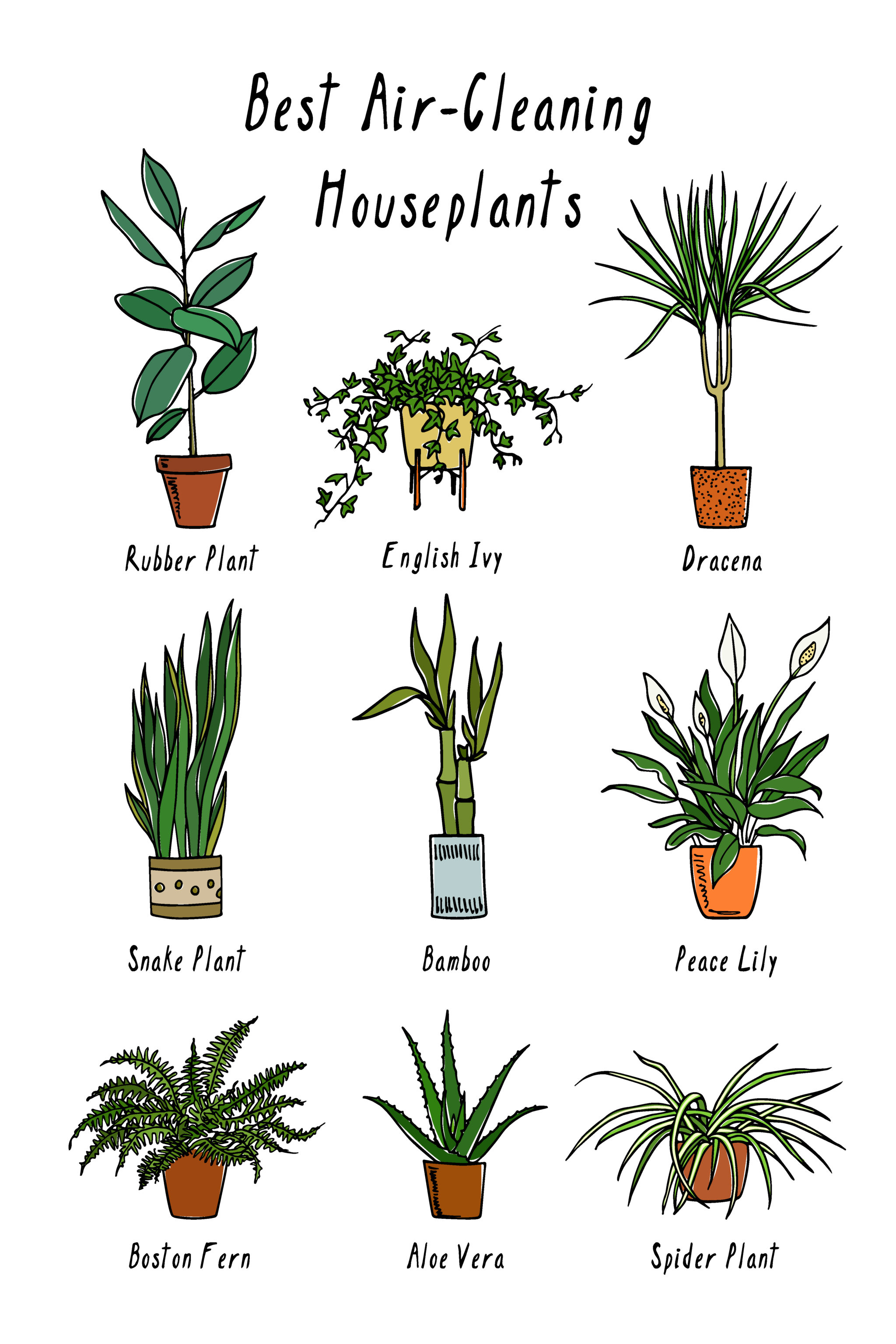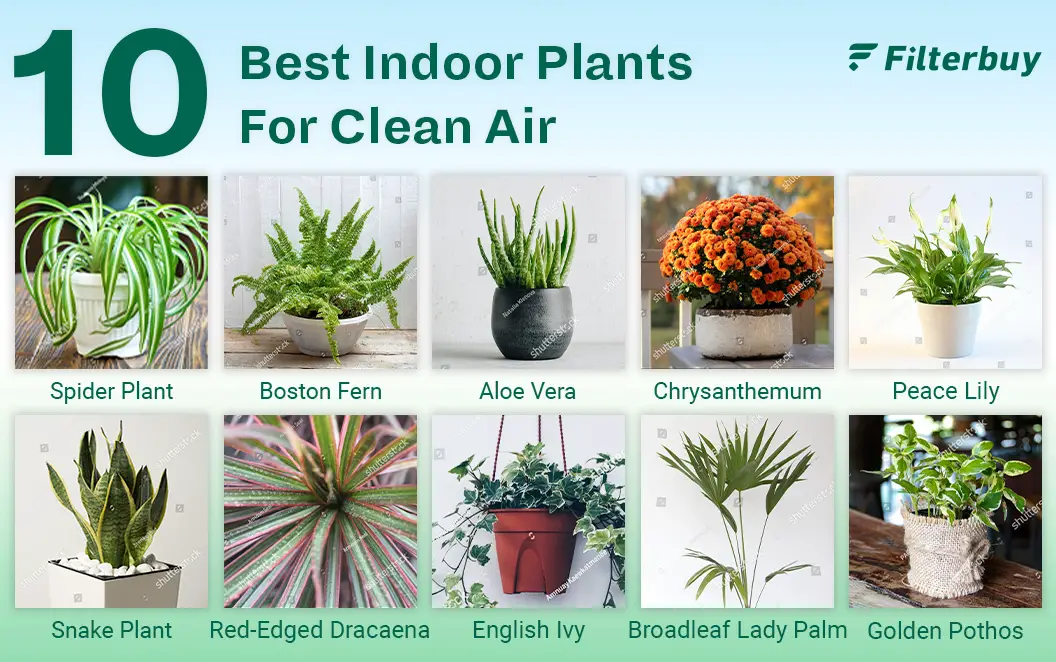To significantly improve indoor air quality, NASA recommends having at least one plant per 100 square feet. This means about 10-15 plants for a typical home.
Indoor plants not only beautify your space but also enhance air quality. Specific houseplants can effectively remove toxins such as formaldehyde, benzene, and trichloroethylene from the air. Popular choices include spider plants, snake plants, and peace lilies. These plants are easy to care for and thrive in indoor environments.
Placing them strategically around your home can maximize their air-purifying benefits. Start by adding a few plants and gradually increase their number. This small step can lead to a healthier living environment. Houseplants are a natural and aesthetic solution for cleaner air.
Introduction To Air-purifying House Plants
House plants can do more than just decorate your home. They can also improve air quality. These plants can remove toxins from the air. This makes your home a healthier place to live.
Importance Of Clean Air
Clean air is crucial for good health. Polluted air can cause breathing problems. It can also lead to other health issues. Clean air helps you sleep better. It also boosts your energy levels. By keeping the air clean, you can improve your overall well-being.
Role Of House Plants
House plants play a big role in cleaning the air. They absorb carbon dioxide and release oxygen. Some plants can remove harmful toxins from the air. These include formaldehyde and benzene. NASA has even studied the benefits of house plants for air purification.
| Plant Name | Toxin Removed |
|---|---|
| Spider Plant | Formaldehyde |
| Peace Lily | Benzene |
| Snake Plant | Trichloroethylene |
Different plants remove different toxins. Having a variety of plants can help clean the air more effectively. Aim to have one plant per 100 square feet of space. This will help maintain good air quality in your home.
- Spider Plant: Removes formaldehyde
- Peace Lily: Removes benzene
- Snake Plant: Removes trichloroethylene
Choose the right plants for your needs. Place them in areas where you spend the most time. This will help you get the most benefits from your house plants.
Popular Air-cleaning Plants
House plants not only beautify your space but also clean the air. Some plants are more effective in purifying indoor air. They remove toxins and improve air quality. Below are some popular air-cleaning plants:
Spider Plant
The Spider Plant is easy to grow and care for. It thrives in bright, indirect sunlight. This plant removes formaldehyde, xylene, and toluene from the air. It’s safe for pets and children. Water the plant when the soil is dry.
Snake Plant
The Snake Plant is also known as “Mother-in-Law’s Tongue.” It is highly resilient and can survive in low light. This plant absorbs toxins like formaldehyde, benzene, and trichloroethylene. It also converts CO2 into oxygen at night. This makes it ideal for bedrooms.
Peace Lily
The Peace Lily has beautiful white flowers. It thrives in low to bright indirect light. This plant removes ammonia, benzene, formaldehyde, and trichloroethylene from the air. It also increases room humidity. Water it once a week and mist the leaves regularly.
Aloe Vera
The Aloe Vera plant is not just an air purifier. It also has medicinal properties. This plant removes formaldehyde and benzene from the air. It requires bright, indirect sunlight. Water it deeply but infrequently. Allow the soil to dry out between waterings.
| Plant | Light Requirement | Air Toxins Removed |
|---|---|---|
| Spider Plant | Bright, indirect sunlight | Formaldehyde, Xylene, Toluene |
| Snake Plant | Low to bright light | Formaldehyde, Benzene, Trichloroethylene |
| Peace Lily | Low to bright indirect light | Ammonia, Benzene, Formaldehyde, Trichloroethylene |
| Aloe Vera | Bright, indirect sunlight | Formaldehyde, Benzene |
How Plants Clean The Air
House plants are not just for decoration. They also clean the air. Plants remove toxins and improve air quality. Learn how they do it below.
Photosynthesis Process
Plants use a process called photosynthesis. They take in carbon dioxide and release oxygen. This process helps clean the air.
Here is how photosynthesis works:
- Plants absorb sunlight through their leaves.
- They take in carbon dioxide from the air.
- They also absorb water through their roots.
- Using sunlight, they convert these into oxygen and glucose.
This process refreshes the air in your home.
Absorption Of Toxins
Plants also remove harmful toxins from the air. They absorb these toxins through their leaves and roots.
Some common toxins plants can remove:
| Toxin | Source | Plant Example |
|---|---|---|
| Formaldehyde | Household cleaners | Spider Plant |
| Benzene | Tobacco smoke | Peace Lily |
| Trichloroethylene | Paints | Boston Fern |
By absorbing these toxins, plants make the air healthier.
Factors Influencing Air Purification
House plants can help clean the air in your home. But how many plants do you need? Several factors influence air purification. Let’s dive into the details.
Plant Size
Bigger plants have more leaves. More leaves mean better air purification. Large plants like fiddle leaf figs and monstera are great choices. They take up more space but clean the air better.
Number Of Plants
More plants mean cleaner air. One or two plants won’t make a big difference. Studies suggest at least two plants per 100 square feet. If you have a big room, you need more plants.
Room Size
The size of the room matters. A small room needs fewer plants. A large room needs more plants. Use this simple table for guidance:
| Room Size (sq ft) | Number of Plants |
|---|---|
| 100 | 2 |
| 200 | 4 |
| 300 | 6 |
Follow these guidelines for clean and fresh air in your home. Remember, the right number of plants is key.
Calculating The Number Of Plants Needed
Understanding how many house plants you need to clean your air is crucial. Plants can improve your indoor air quality. But how many do you need? Let’s explore this in detail.
Research Findings
Research indicates house plants can purify the air. A famous NASA study showed this. They found certain plants remove toxins from the air. The study suggested having many plants for better results.
For example, NASA recommended 15-18 plants in an 1,800 square feet area. This means 1 plant per 100 square feet. These findings are a good starting point.
Practical Guidelines
Here are some practical guidelines to help you:
- Plant Size: Larger plants clean more air.
- Plant Variety: Use different types of plants.
- Room Size: Adjust the number of plants to room size.
Let’s break this down further in a table:
| Room Size (sq. ft.) | Number of Plants |
|---|---|
| 100 | 1 |
| 200 | 2 |
| 500 | 5 |
| 1000 | 10 |
These guidelines are simple to follow. Ensure you have enough plants for your space. This will help in keeping your air clean and fresh.

Credit: molekule.com
Placement Of House Plants
Placing house plants in the right spots can improve air quality. The location of each plant matters for both aesthetics and functionality. Correct placement helps plants thrive and effectively clean the air.
Optimal Locations
Plants need light to grow and purify air. Place them near windows for natural light. East-facing windows are ideal for most house plants.
- Living Room: Corners and side tables are great spots.
- Bedroom: Nightstands and shelves work well.
- Kitchen: Countertops and window sills are optimal.
These spots ensure plants get enough light and are easily seen.
Avoiding Overcrowding
Overcrowding plants can hinder their growth and air-purifying ability. Each plant needs space to spread its leaves.
- Keep at least 12 inches between plants.
- Use different heights to create a balanced look.
- Avoid placing large plants too close together.
Proper spacing helps plants to breathe and grow well.
Maintenance Tips For Air-purifying Plants
Maintaining your air-purifying plants is vital for their health and effectiveness. Proper care ensures they thrive and purify your air efficiently. Below are some essential maintenance tips to keep your plants healthy.
Watering And Feeding
Watering is crucial for plant health. Ensure the soil stays moist but not soggy. Over-watering can lead to root rot, while under-watering can dry them out. Use a well-draining potting mix to balance moisture.
- Check soil moisture regularly.
- Use room temperature water.
- Water plants in the morning.
Feeding your plants provides them with necessary nutrients. Use a balanced, water-soluble fertilizer. Feed them every two to four weeks during the growing season.
- Follow the fertilizer instructions.
- Avoid over-fertilizing.
- Feed less in winter.
Dealing With Pests
Pests can harm your plants and hinder their air-purifying abilities. Regularly inspect your plants for any signs of pests. Common pests include spider mites, aphids, and mealybugs.
| Pest | Signs | Solution |
|---|---|---|
| Spider Mites | Webbing on leaves | Use insecticidal soap |
| Aphids | Sticky residue | Spray with water |
| Mealybugs | White cottony spots | Wipe with alcohol |
Prevent pests by keeping your plants clean. Remove dead leaves and debris. Ensure good air circulation around your plants.
Following these maintenance tips will help your air-purifying plants thrive. Healthy plants mean cleaner air for you and your family.

Credit: planterra.com
Additional Benefits Of House Plants
House plants do more than clean the air. They bring many extra benefits. These green friends can improve your life in surprising ways.
Improving Mood
Having house plants can boost your mood. Plants make you feel happier and calmer. They reduce stress and anxiety. Green plants have a soothing effect on your mind. They give you a sense of peace and well-being.
Enhancing Decor
House plants can enhance your home decor. They add beauty and color to any room. You can choose plants with different shapes and sizes. They can fit into any style of home. Use a small plant on a desk or a large one in the corner. Each plant can make your space look more lively.
| Plant Type | Decor Style |
|---|---|
| Succulents | Modern |
| Ferns | Traditional |
| Spider Plants | Bohemian |
- Natural Beauty: Plants bring a touch of nature indoors.
- Color Variety: Different plants offer a range of colors.
- Versatility: They can be placed anywhere in your home.
Plants are not just for cleaning the air. They improve your mood and make your home look beautiful. Enjoy the many benefits of having house plants.
Conclusion And Recommendations
Determining the number of houseplants needed to clean the air can be tricky. This section provides a summary of key points and best practices for achieving cleaner air with houseplants. Follow these guidelines to ensure a healthier indoor environment.
Summary Of Key Points
- Houseplants can improve indoor air quality by removing toxins.
- The NASA Clean Air Study suggests certain plants are more effective.
- Plant variety and quantity both play a role in air purification.
- For noticeable air quality improvement, aim for one plant per 100 square feet.
Best Practices
To maximize the air-cleaning benefits of houseplants, follow these best practices:
- Choose the Right Plants: Opt for plants known for their air-purifying qualities, like Spider Plants and Peace Lilies.
- Maintain Your Plants: Regularly water and prune them to keep them healthy.
- Distribute Evenly: Place plants in various rooms to ensure even air purification.
- Monitor Growth: Ensure plants have enough light and space to grow.
| Plant | Best For | Care Level |
|---|---|---|
| Spider Plant | Removing formaldehyde | Easy |
| Peace Lily | Eliminating mold spores | Moderate |
| Bamboo Palm | Filtering benzene | Moderate |
Remember to adjust the number of plants based on room size. Use the recommended one plant per 100 square feet as a guideline. This ensures optimal air purification without overcrowding your space.

Credit: www.haywardscore.com
Frequently Asked Questions
How Many Indoor Plants Do You Need To Improve Air Quality?
To improve air quality, place at least one indoor plant per 100 square feet. Popular choices include spider plants, peace lilies, and snake plants.
How Many Plants Do I Need To Purify Air?
You need at least 2-3 plants per 100 square feet to effectively purify indoor air. Popular choices include spider plants, peace lilies, and snake plants.
How Much Do House Plants Clean Air?
House plants can improve air quality by removing toxins. They absorb pollutants through their leaves and roots. However, their impact is limited compared to other ventilation methods.
How Many Plants Do You Need For Fresh Air?
For fresh air, aim for 1-2 plants per 100 square feet. Popular choices include spider plants and peace lilies.
Conclusion
Houseplants can significantly improve indoor air quality. Choose the right plants and quantity for your space. Monitor their health and ensure proper care. Cleaner air benefits your well-being and home environment. Start with a few plants and adjust as needed.
Enjoy the fresh, purified air they provide.

My mission is to help you bring the beauty of nature indoors with expert advice, detailed plant care guides, and creative design ideas.





Leave a Reply